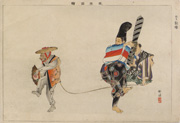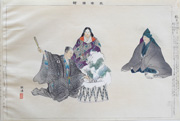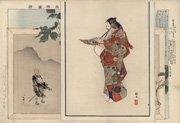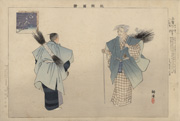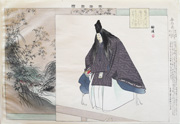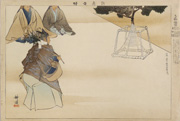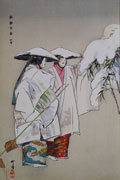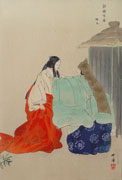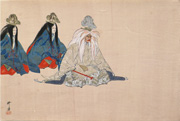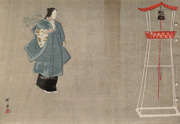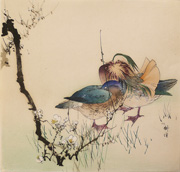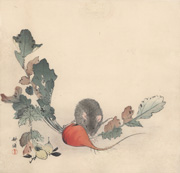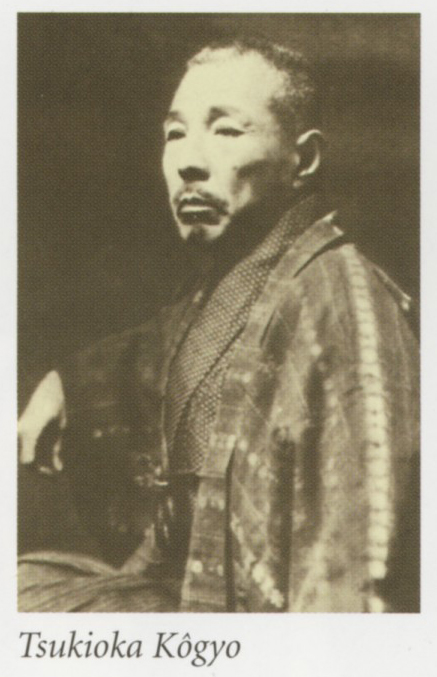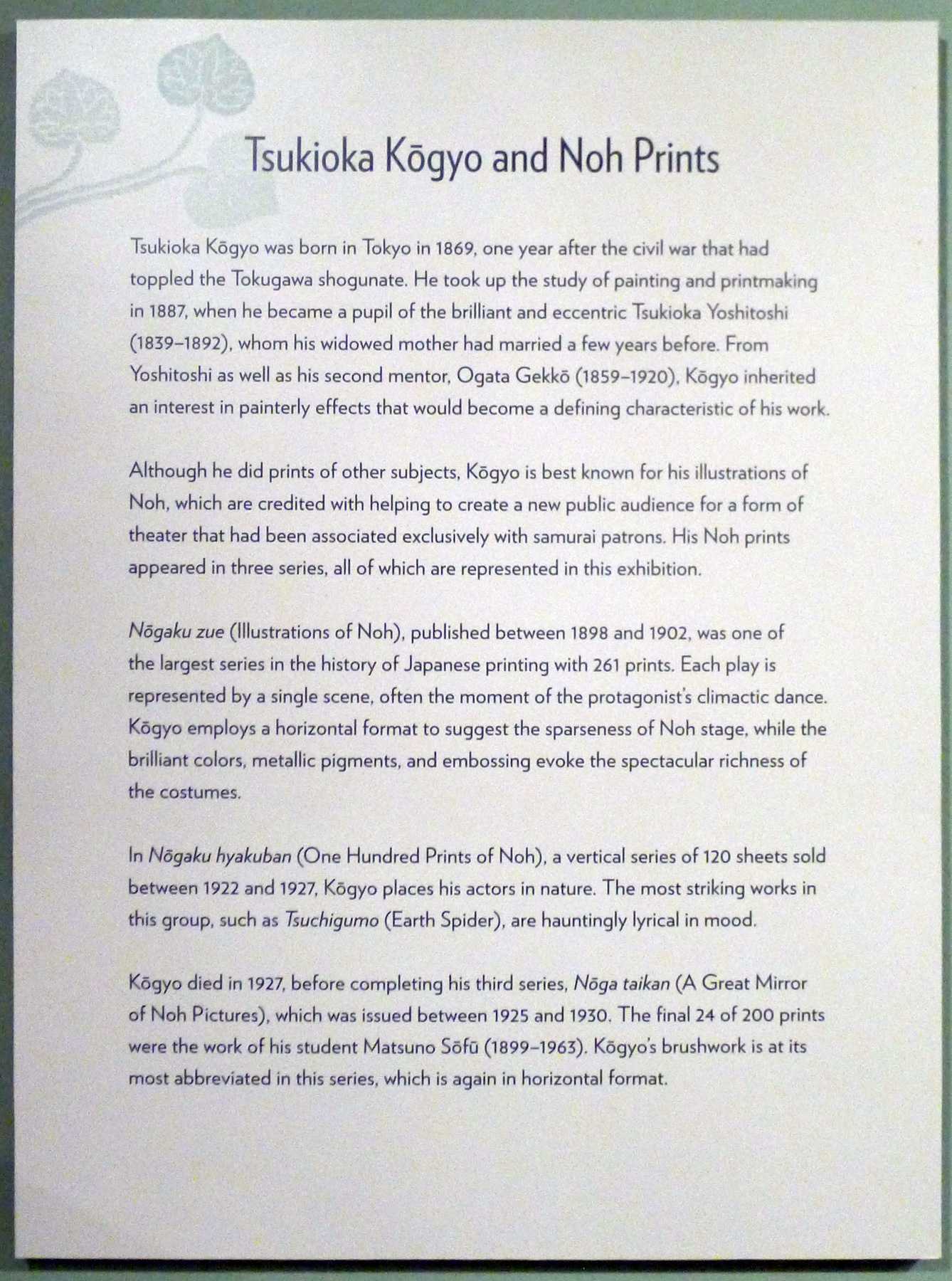Prints in Collection
Nōgakuzue, Mokuroku, zenpen
(Index, volume 1, no. 1), 1897-1902
IHL Cat. #1264Nōgakuzue, Mokuroku, kōhen, jō
(Index, volume 2, no. 2), 1897-1902
IHL Cat. #939
October 15, 1904
(earliest known date of issuance
? 1897)
IHL Cat. #495
date trimmed
(earliest known date of issuance
June 1, 1897)
IHL Cat. #208
September 5, 1897
(earliest known date of issuance September 5, 1897)
IHL Cat. #1144
September ?, 1897
(earliest known date of issuance September 15?, 1897)
IHL Cat. #1135Nōgakuzue, Rokujizō (Kyōgen),
October 5, 1897
(earliest known date of issuance
October 5, 1897)
IHL Cat. #807
IHL Cat. #1045
IHL Cat. #207
November 10, 1897
(earliest known date of issuance
November 10, 1897)
IHL Cat. #1146
Nōgakuzue, Kurama Tengu,
November 10, 1897
(earliest known date of issuance November 10, 1897)
IH Cat #806
Nōgakuzue, Yorimasa,
February 10, 1898
(earliest known date of issuance
February 10, 1898)
IHL Cat. #1134
Nōgakuzue, Morihisa,
date trimmed
(earliest known date of issuance
May 10, 1898)
IHL Cat. #1928
Nōgakuzue, Shunkan,
October ?, 1898
(earliest known date of issuance
February 15, 1898)
IHL Cat. #999
Nōgakuzue, Yōkihi,
date trimmed
(earliest known date of issuance
October 10, 1898)
IHL Cat. #1927
IHL Cat. #998
Nōgakuzue, Sotoba Komachi,
March 12, 1898
(earliest known date of issuance
March 12, 1898)
IHL Cat. #945
Nōkaguzue, Mochizuki,
July 5, 1898
(earliest known date of issuance
July 5, 1898)
IHL Cat. #1646
Nōgakuzue, Tamakazura,
January 10, 1899
(earliest known date of issuance Janauary 10, 1899)
IHL Cat. #1136Nōgakuzue, Ohara gokō,
January 15, 1899
(earliest known date of issuance
January 15, 1899)
IHL Cat. #206
Nōgakuzue, Kayoi Komachi,
date trimmedi
(earliest known date of issuance
January 16, 1899)
IHL Cat. #1929
Nōgakuzue, Kusu no tsuyu,
April 20, 1899
(earliest known date of issuance
April 20, 1899)
IHL Cat. #1149, #1896, #1923
Nōgakuzue, Tenko,
June 5, 1899
(earliest known date of issuance
June 5, 1899)
IHL Cat. #946 and IHL Cat. #1925
Nōgakuzue, Tsūen (Kyōgen),
September 25, 1899
(earliest known date of issuance September 25, 1899)
IHL Cat. #944
September 25, 1899
(earliest known date of issuance September 25, 1899)
IHL Cat. #1046
Nōgakuzue, Oshio,
October 10, 1899
(earliest known date of issuance
October 10, 1899)
IHL Cat. #1645
Nōgakuzue, Kanawa,
October 10, 1899
(earliest known date of issuance
October 10, 1899)
IHL Cat. #1673
Nōgakuzue, Ikuta Atsumori,
date trimmed
(earliest known date of issuance
October 25, 1899)
IHL Cat. #1926
Nōgakuzue, Ominameshi,
November 15, 1899
(earliest known date of issuance November 15, 1899)
IHL Cat. #1048
Nōgakuzue, Ema,
date trimmed
(earliest known date of issuance December 25, 1899)
IHL Cat. #888
Nōgakuzue, Oba ga sake (Kyōgen), January 15, 1900
(earliest known date of issuance
January 15, 1900)
IHL Cat. #704
Nōgakuzue, Saigyō Zakura
March 5, 1900
(earlies known date of issuance
1898 or 1899)
IHL Cat. #1748
Nōgakuzue, Tomoakira,
May 10, 1900
(earliest known date of issuance
May 10, 1900)
IHL Cat. #390
Nōgakuzue, Asō,
date trimmed
(earliest known date of issuance
c. 1901)
IHL Cat. #1930
Nōgakuzue, Kirokuda (Kyōgen),
April 5, 1901
(earliest known date of issuance
April 5, 1901)
IHL Cat. #209Nōgakuzue, Yuki,
July 10, 1901
(earliest known date of issuance
July 10, 1901)
IHL Cat. #205
Nōgakuzue, Rō Giō,
February ?, 1902
(earliest known date of issuance
February ?, 1902)
IHL Cat. #204
January 25, 1899)
Nōgakuzue, Unoha,
May ?, 1902
(earliest known date of issuanceMay 5, 1902)IHL Cat. #1924
IHL Cat. #153
IHL Cat. #267
Nōgaku hyakuban #19/20/21,
Okina, 1923
IHL Cat. #836
Nōgaku hyakuban #23,
Ukai, 1923
IHL Cat. #162
IHL Cat. #824
Hashi Benkei, 1923
IHL Cat. #821
Nōgaku hyakuban, #32 Yōkihi, 1923
IHL Cat. #1940
Nōgaku hyakuban #41,
Take no Yuki, 1923
IHL Cat. #155
Nōgaku hyakuban #42, Kinsatsu, 1923
IHL Cat. #2215
Nōgaku hyakuban #44, Kazuraki, 1924
IHL Cat. #283
Nōgaku hyakuban #47, Semimaru, 1924
IHL Cat. #328
Nōgaku hyakuban #49,
Izutsu, 1924
IHL Cat. #407
Nōgaku hyakuban #69, Tōboku, 1925
IHL Cat. #329
Nōgaku hyakuban #71, Yoshino Tennin, 1925
IHL Cat. #151
Nōgaku hyakuban #90,
Ema, 1925
IHL Cat. #1020
Nōgaku hyakuban #106, Atagokūya, 1926
IHL Cat. #258
Nōgaku hyakuban #108,
Mekari, 1926
IHL Cat. #270
Nōgaku hyakuban #117, Ōmu Komachi, 1926
IHL Cat. #161Nōgaku hyakuban #118,
Kayoi Komachi, 1926
IHL Cat. #284
-intentionally left blank-Nōgaku hyakuban #120,
Yumi yawata, 1926
IHL Cat. #152
1925-1930
IHL Cat. #144
1925-1930
IHL Cat. #175
1925-1930
IHL Cat. #138
1925-1930
IHL Cat. #139
1925-1930
IHL Cat. #176
1925-1930
IHL Cat. #145
1925-1930
IHL Cat. #140
1925-1930
IHL Cat. #126
1925-1930
IHL Cat. #134
1925-1930
IHL Cat. #146
1925-1930
IHL Cat. #338
1925-1930
IHL Cat. 337
1925-1930
IHL Cat. #336
1925-1930
IHL Cat. #335
1925-1930
IHL Cat. #334
1925-1930
IHL Cat. #330
1925-1930
IHL Cat. #135
1926
IHL Cat. #793
1925-1930
IHL Cat. #215
1925-1930
IHL Cat. #142
1925-1930
IHL Cat. #285
1925-1930
IHL Cat. #214
1925-1930
IHL Cat. #141
1925-1930
IHL Cat. #128
1925-1930
IHL Cat. #122
1925-1930
IHL Cat. #123
1925-1930
IHL Cat. #125
1925-1930
IHL Cat. #124
1925-1930
IHL Cat. #127
1925-1930
IHL Cat. #441
Nōga taikan, Tôei
1925-1930
IHL Cat. #594
Nōga taikan, Kasuga Ryūjin 1925-1930
IHL Cat. #595
Nōga taikan, Kosode Soga 1925-1930
IHL Cat. #596
Nōga taikan, Himuro
1925-1930
IHL Cat. #707
Nōga taikan, Fujidaiko
1925-1930
IHL Cat. #706
Nōga taikan, Aridōshi
1925-1930
IHL Cat. #674
Nōga taikan, Manjū (Nakamitsu)
1926
IHL Cat. #725
Nōga taikan, Kōtei
1926
IHL Cat. #726
Nōga taikan, Ema
1926
IHL Cat. #727
Nōga taikan, Higaki
1926
IHL Cat. #728
Nōga taikan, Obasute
1926
IHL Cat. #729
Nōga taikan, Aya no Tsuzumi
1926-1930
IHL Cat. #753
Nōga taikan, Nishiki-gi
1926-1930
IHL Cat. #754
Nōga taikan, Minazuki Barae
1926
IHL Cat. #794
Nōga taikan, Shirahige
1926-1930
IHL Cat. #756
Nōga taikan, Ugetsu, 1926
IHL Cat. #788
Nōga taikan, Seiganji, 1926
IHL Cat. #789
Nōga taikan, Daibutsu Kuyō, 1926
IHL Cat. #790
Nōga taikan, Izutsu, 1926
IHL Cat. #791
Nōga taikan, Miidera, 1926
IHL Cat. #792
Nōga taikan, Unrin'in, 1926
IHL Cat. #795
Nōga taikan, Kiso, 1926
IHL Cat. #796
Nōga taikan, Ama, 1926
IHL Cat. #797
Nōga taikan, Makura Jidō, 1926
IHL Cat. #798
Nōga taikan, Kogō, 1926
IHL Cat. #799
Nōga taikan, Shakkyō, 1926
IHL Cat. #800
Nōga taikan, Kinsatsu, 1926
IHL Cat. #844
Nōga taikan, Kurozuka, 1925-1930
IHL Cat. #842
Nōga taikan, Dampū, 1925-1930
IHL Cat. #1216
Nōga taikan, Yumi Yawata, 1925-1930
IHL Cat. #1660
Nōga taikan, Kamo Monogurui,
1925-1930
IHL Cat. #1661
Nōga taikan, Sanemori,
1925-1930
IHL Cat. #1728
Nōga taikan, Yuya,
1925-1930
IHL Cat. #1729
1925-1930
IHL Cat. #1894
-intentionally left blank-
Russo-Japanese War Pictorial part 6:
Fierce Fight in the Vicinity of Pyongyang, 1904
IHL Cat. #535
IHL Cat. #889
Ducks with Flowering Plum, c. 1900
IHL Cat. #1018
Rat and Radish, c. 1900
IHL Cat. #1516
Rat and Radish, c. 1900
IHL Cat. #2141
Quails and Full Moon, c. 1900
IHL Cat. #1715
Biographical Data
1 The Theatre Prints of Tsukioka Kogyō: from the collection of Richard and Mae Smethurst, Yatsutaka Maruki and Laurence Kominz (a pamphlet from the 2007 exhibition of the same name.)
2 The Frick Art & Historical Center website http://www.frickart.org/collection_exhibitions/pastexhibitions/80.php
3 Ibid.
4 Ibid., quote by Richard Smethurst, professor of Japanese history at the University of Pittsburgh.
Kōgyo was twenty-three when Yoshitoshi died. His mother then succeeded his stepfather as head of the Tsukioka family and its workshop until her death in 1911. Kōgyo at this time published his art under the name of his mother's family, Sakamaki 坂巻. He later became the student of another well-known print artist of the Meiji period (1868-1912), Ogata Gekkō (1859-1920). Following Japanese tradition, Gekkō gave his student a new name, "Kōgyo." Consequently, from the mid-1890s on, he was known as Sakamaki Kōgyo and, after his 1911 assumption of leadership of the Tsukioka school, as Tsukioka Kōgyo. He also used the artist names (gō) Kōhan 湖畔 (appearing on his small landscape prints). Gyo 漁, Rekizan 歴山 and Nenkyu. It is also reported that Kōgyo was a pupil of Matsumoto Fuko (1840-1923), a Japanese-style painter.1
Kōgyo had a least one child, a daughter Fumio who became the artist Tsukioka Gyokusei (1908-1994), who took over the Tsukioka school after Kōgyo's death in 1927. She described her father's working habits as follows:
1 A Dictionary of Japanese Artists: Painting, Sculpture, Ceramics, Prints, Lacquer, Laurance P. Roberts, Weatherhill, 1976, p. 189.
2 The Prints of Tsukioka Kōgyo, a brochure from the exhibition of the same name held at the Frick Art Museum February 3 - April 7, 2007
Kōgyo created three major series of prints related to the Noh theater, all published by Matsuki Heikichi 松木平吉, proprietor of Daikokuya 大黒屋.
The first series, begun in 1897 and completed in 1902, Nōgakuzue (Illustrations of Noh), consists of 261 prints all in the horizontal oban format. The second series, Nōgaku hyakuban (One Hundred Prints of the Noh), consists of 120 prints, almost all in the vertical oban format. The last series, Nōga taikan (A Great Collection of Noh Pictures), featuring 200 prints, was completed by his student Matsuno Sōfū (1899-1963) after Kogyo's death in 1927 and are all in the horizontal oban format.
First Series (1897-1902)1 - Nōgakuzue (Illustrations of Noh; aka Pictures of Noh Plays or Pictures of Noh Performances)
The 261 prints comprising this first series show the primary actor (shite) often accompanied by one or two other performers (known as the waki, tsure, or aikyōgen), stage props, and sometimes the larger milieu including musicians or stage architecture. In the right margin Kōgyo gives the title of the play, a list of the roles, and a brief synopsis of the story. Occasionally there is an insert including an excerpt from the play's text. He also includes naturalistic details that evoke the setting of the plays, or "windows" of information that portray parts of the story that are relevant but do not actually take place on stage - events that are referred to but not seen. In the left margin is the publication date and publisher's name.2 Each print is signed Kōgyo 耕漁.
Of the 261 prints, 221 prints are of 220 noh plays, 27 prints are of kyōgen plays, and 13 are miscellaneous prints. The 27 kyōgen plays only give the title of the play in the right margin and have no additional descriptive information about the play.
Tsukioka Kōgyo 月岡耕漁 (1869-1927) Kōgyo was born the year after the beginning of the Meiji restoration, which brought Japan into the modern Western world. While this was to be a period of great political and social upheaval in Japanese society, Kōgyo's work was largely focused on the traditional, the theater of Noh. In his lifetime he created over 550 prints, in three major print series, documenting Noh performances, with particular focus on the costumes and poses of the actors. These prints were widely distributed, many appearing in magazines, books and posters.1 At the age of fifteen he apprenticed with the great woodblock artist Tsukioka Yoshitoshi (1839-1892), who had married his mother. His interest in Noh was likely sparked by Yoshitoshi, who had a "lifelong fascination with Noh."2 After Yoshitoshi's death, he went on to study with the painter and woodblock artist Ogata Gekkō (1859-1920), who likely was instrumental in the development of Kōgyo's watercolor-like, painterly style and his synthesis of Western and traditional Japanese artistic styles. The Noh prints created by Kōgyo serve as "an artistically elegant and beautiful record of this theatrical genre's customs and performances"3 that "stand in their own right as works of art."4 |
2 The Frick Art & Historical Center website http://www.frickart.org/collection_exhibitions/pastexhibitions/80.php
3 Ibid.
4 Ibid., quote by Richard Smethurst, professor of Japanese history at the University of Pittsburgh.
Biography
While much has been written about Kōgyo's Noh prints, little has been written about his life. The English-language literature reports that he was born Hanyū Bennosuke, the son of innkeepers in Nihonbashi, Tokyo. When he was fifteen years old, his mother married Tsukioka Yoshitoshi (1839-1892), a distinguished master of ukiyo-e printmaking. From his famous stepfather, the young Kōgyo received some of his earliest training in printmaking and painting. He received the name Toshihisa 年久 (the toshi 年 taken from his stepfather’s name), a name that was to appear on some of his war triptychs. Although their styles and subject matter were different, Kōgyo acquired both a knowledge of print design and an enthusiasm for Noh theater from his stepfather, who had a lifelong fascination with Noh.Kōgyo was twenty-three when Yoshitoshi died. His mother then succeeded his stepfather as head of the Tsukioka family and its workshop until her death in 1911. Kōgyo at this time published his art under the name of his mother's family, Sakamaki 坂巻. He later became the student of another well-known print artist of the Meiji period (1868-1912), Ogata Gekkō (1859-1920). Following Japanese tradition, Gekkō gave his student a new name, "Kōgyo." Consequently, from the mid-1890s on, he was known as Sakamaki Kōgyo and, after his 1911 assumption of leadership of the Tsukioka school, as Tsukioka Kōgyo. He also used the artist names (gō) Kōhan 湖畔 (appearing on his small landscape prints). Gyo 漁, Rekizan 歴山 and Nenkyu. It is also reported that Kōgyo was a pupil of Matsumoto Fuko (1840-1923), a Japanese-style painter.1
Kōgyo had a least one child, a daughter Fumio who became the artist Tsukioka Gyokusei (1908-1994), who took over the Tsukioka school after Kōgyo's death in 1927. She described her father's working habits as follows:
| I remember beginning at the age of fifteen going to the Kanze Noh stage at Omigari in Tokyo with my father. Before the play began, father would sketch the stage, beginning with the hashigakari. People around him were amazed at the speed and facility with which he drew… When father was absorbed with a painting, he worked with a fierce look on his face, and I knew not to enter his studio.2 |
2 The Prints of Tsukioka Kōgyo, a brochure from the exhibition of the same name held at the Frick Art Museum February 3 - April 7, 2007
Noh Print Series
Sources: The Prints of Tsukioka Kogyo, a brochure from the exhibition of the same name held at the Frick Art Museum February 3 - April 7, 2007 and as footnoted.Kōgyo created three major series of prints related to the Noh theater, all published by Matsuki Heikichi 松木平吉, proprietor of Daikokuya 大黒屋.
The first series, begun in 1897 and completed in 1902, Nōgakuzue (Illustrations of Noh), consists of 261 prints all in the horizontal oban format. The second series, Nōgaku hyakuban (One Hundred Prints of the Noh), consists of 120 prints, almost all in the vertical oban format. The last series, Nōga taikan (A Great Collection of Noh Pictures), featuring 200 prints, was completed by his student Matsuno Sōfū (1899-1963) after Kogyo's death in 1927 and are all in the horizontal oban format.
First Series (1897-1902)1 - Nōgakuzue (Illustrations of Noh; aka Pictures of Noh Plays or Pictures of Noh Performances)
The 261 prints comprising this first series show the primary actor (shite) often accompanied by one or two other performers (known as the waki, tsure, or aikyōgen), stage props, and sometimes the larger milieu including musicians or stage architecture. In the right margin Kōgyo gives the title of the play, a list of the roles, and a brief synopsis of the story. Occasionally there is an insert including an excerpt from the play's text. He also includes naturalistic details that evoke the setting of the plays, or "windows" of information that portray parts of the story that are relevant but do not actually take place on stage - events that are referred to but not seen. In the left margin is the publication date and publisher's name.2 Each print is signed Kōgyo 耕漁.
Of the 261 prints, 221 prints are of 220 noh plays, 27 prints are of kyōgen plays, and 13 are miscellaneous prints. The 27 kyōgen plays only give the title of the play in the right margin and have no additional descriptive information about the play.
Examples of artist seals used in this series:
1 While the year 1901 is also cited as the end date for this series, IHL Cat. #204 Rō Giō carries the date Meiji 33 or 1902.
2 "Tsukioka Kōgyo and Nō Ukiyo-e," Don Bondi, Daruma Japanese Art & Antiques Magazine, Issue 52, Autumn 2006, p. 14.
Second Series (1922-1926) - Nōgaku hyakuban 能楽百番 (One Hundred Prints of the Noh)
Nōgaku hyakuban, Tsuchigumo, 1922
IHL Cat. #153
IHL Cat. #153
This second series of prints consists of 120 prints derived from 100 plays. Fourteen diptych and three triptych prints were included in this series. These prints are quite different from those in the first series. The principal actor is nearly always the focus of the composition and all the prints are in vertical rather than horizontal oban format. "The backgrounds often contain rich gradations of color, or dramatic, painterly suggestions of a setting. The monumentality of the figure creates a powerful, authoritative tone."1
The prints of the Nōgaku hyakuban series were sold by subscription. Three prints placed in an envelope were issued on a monthly basis starting with no. 1 in July 1922 and ending in September 1926 with print no. 120. Issuance of the prints was interrupted for approximately one year as a result of the 1923 Great Kanto Earthquake that devastated much of Tokyo. Only the envelopes indicate the time of publication, whereas the information about the publisher was also given by a seal on the prints.2

Table of Contents Envelope 1
(“The series Nōgaku hyakuban (100 No plays),” Claus-Peter Schulz, Andon 67, p. 28, fig. 3.)
Claus-Peter Schultz who had done extensive research on Tsukioka Kōgyo and his work kindly provided the following information to me:
"With regard to your question on the albums: the albums have been distributed once the series has been completed (i.e. after September 1926). The order in the albums does not comply with the order of the 1st publishing (i.e. the distribution in 40 envelopes of three sheets each). Your contents sheet (cat.#246) belongs to volume 1."
(“The series Nōgaku hyakuban (100 No plays),” Claus-Peter Schulz, Andon 67, p. 28, fig. 3.)
Issued as an Album? (The question is now answered!)
Many of the prints seen from this series, including a number in this collection, have a heavy backing and are partially trimmed, indicative of once being mounted in an album. It is unknown whether these albums were created by collectors or the publisher. My guess is that the publisher did create albums for this series and may have issued separate index sheets, such as the print IHL Cat. #246 in this collection, for these albums.
Many of the prints seen from this series, including a number in this collection, have a heavy backing and are partially trimmed, indicative of once being mounted in an album. It is unknown whether these albums were created by collectors or the publisher. My guess is that the publisher did create albums for this series and may have issued separate index sheets, such as the print IHL Cat. #246 in this collection, for these albums.
Claus-Peter Schultz who had done extensive research on Tsukioka Kōgyo and his work kindly provided the following information to me:
"With regard to your question on the albums: the albums have been distributed once the series has been completed (i.e. after September 1926). The order in the albums does not comply with the order of the 1st publishing (i.e. the distribution in 40 envelopes of three sheets each). Your contents sheet (cat.#246) belongs to volume 1."
1 The Prints of Tsukioka Kōgyo, a brochure from the exhibition of the same name held at the Frick Art Museum February 3 - April 7, 2007
2 “The series Nōgaku hyakuban (100 No plays) by Tsukioka Kōgyo (1869-1927),” Claus-Peter Schulz, Andon 67, Society for Japanese Arts, p. 28.
Examples of seals used in this series:
Third Series (1925-1930) - Nōga taikan 能画大鑑 (Encyclopedia of Noh Plays)
Kōgyo's last series completed after his death consists of 200 prints, 24 of which were made by his student Matsuno Sōfū (1899-1963). The prints in this series tend to be further simplified, with the isolation of the figure less expressive.1
The prints were organized into five volumes (examples of which are shown below) and each print had an interleaved sheet with descriptive information2. The twenty four prints designed by Matsuno were published as part of volume 13 on January 25, 1930.4
This series is variously translated as Encyclopedia of Noh Plays, A Great Collection of Noh Pictures, A Great Collection of Noh Plays, Noh Print Survey, Pictures of Noh Plays, A Great Mirror of Noh Plays.
1 “The series Nogaku hyakuban (100 No plays),” Claus-Peter Schulz, Andon 67 p. 28.
2 These thin descriptive sheets are almost never seen outside of the albums, as they were discarded when the prints were removed from albums for individual sale. However, a number of prints in this collection still have their descriptive sheets.
3If my understanding is correct, Volume 1 was issued after volumes 2-4, the first volume of which was issued in July 1925.
4 Information supplied by Claus-Peter Schulz.
5 The Beauty of Silence: Nō and Nature Prints by Tsukioka Kōgyo (1869-1927), Robert Schaap & J. Thomas Rimer, Hotei Publishing, 2010, p. 36.
Final Series of Prints (1927) - Kyōgen gojūban (Fifty Kyōgen Plays)
Source: The University of Pittsburgh comprehensive website on Tsukioka Kogyo http://digital.library.pitt.edu/k/kogyo/kyogen_gojuban.html
Kyōgen Gōjūban is a series of fifty prints depicting kyōgen, or comedy plays, plus a table of contents. While the series Nōgakuzue includes some prints illustrating scenes from kyōgen, Kyōgen Gōjūban is devoted exclusively to them. Kyōgen Gōjūban's prints are multi-color, multi-block woodblock prints on heavy wove paper. The images are full-page, horizontal in orientation, each measuring about 10 x 15 in. (25.6 x 37.9 cm). Pigments are water-based, sometimes embellished with gold and silver mica highlights. The background is often shaded by a thin wash, and the printing technique imitates hand-painted water color, notably so in the masterful prints signed by Kōgyo.
Kōgyo's signature appears on sixteen prints in this series and the signature of his daughter, Tsukioka Gyokusei (1908-2009), using her artist's name Kōbun 江文, appears on thirty-four.
Kyōgen are usually performed between Noh plays presented on the same day. Kyōgen actors speak rather than chant their lines and usually do not wear masks. They are masters of physical comedy and slapstick humor.
To view the entire series of prints in a bound album format go to http://digital.library.pitt.edu/k/kogyo/kyogen_gojuban.html.
Other Work
 In addition to hundreds of Noh-subject prints, Kōgyo created a number of kacho-e (prints of birds and flowers), many in the shikishiban format as shown on the left, a few small-format landscape prints, several senso-e (war prints) of the Russo-Japanese War (1904-1905) and a few prints depicting the modernization of Japan, such as the print Congratulations and Long Life Prince Yoshihito and Princess Sadako in this collection. He produced over three dozen Noh paintings and over one hundred fifty illustrations of Noh and non-Noh illustrations for Japan's first graphic magazine, Fûzoku gahô. He also produced small postcard prints for the Noh publishing house, Wan'ya.
In addition to hundreds of Noh-subject prints, Kōgyo created a number of kacho-e (prints of birds and flowers), many in the shikishiban format as shown on the left, a few small-format landscape prints, several senso-e (war prints) of the Russo-Japanese War (1904-1905) and a few prints depicting the modernization of Japan, such as the print Congratulations and Long Life Prince Yoshihito and Princess Sadako in this collection. He produced over three dozen Noh paintings and over one hundred fifty illustrations of Noh and non-Noh illustrations for Japan's first graphic magazine, Fûzoku gahô. He also produced small postcard prints for the Noh publishing house, Wan'ya.
Kōgyo's last series completed after his death consists of 200 prints, 24 of which were made by his student Matsuno Sōfū (1899-1963). The prints in this series tend to be further simplified, with the isolation of the figure less expressive.1
The prints were organized into five volumes (examples of which are shown below) and each print had an interleaved sheet with descriptive information2. The twenty four prints designed by Matsuno were published as part of volume 13 on January 25, 1930.4
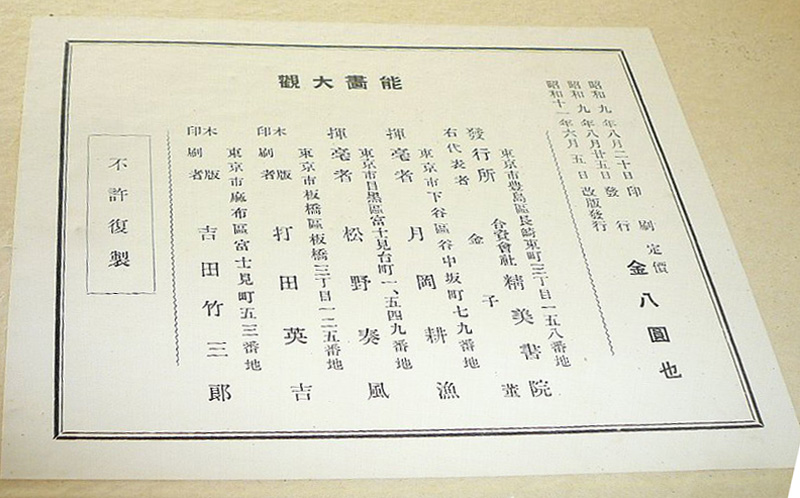 |  |
| click on image to enlarge 1936 edition folio and colophon | "... [S]econd (1934) and third (1936) editions were released, and the publication of further editions suggests that the set was popular. The third edition is an album of 144 prints drawn from the original series. Another edition (with the same colophon as the album of 144 prints) also exists as a folder with fifty prints. Both this and the third edition have semi-transparent cover sheets on each print with the play title and plot synopsis, which were probably printed using a mechanical typeset process. This suggests that cheaper printing techniques were chosen over woodblock printing during the 1930s."5 |
This series is variously translated as Encyclopedia of Noh Plays, A Great Collection of Noh Pictures, A Great Collection of Noh Plays, Noh Print Survey, Pictures of Noh Plays, A Great Mirror of Noh Plays.
2 These thin descriptive sheets are almost never seen outside of the albums, as they were discarded when the prints were removed from albums for individual sale. However, a number of prints in this collection still have their descriptive sheets.
3If my understanding is correct, Volume 1 was issued after volumes 2-4, the first volume of which was issued in July 1925.
4 Information supplied by Claus-Peter Schulz.
5 The Beauty of Silence: Nō and Nature Prints by Tsukioka Kōgyo (1869-1927), Robert Schaap & J. Thomas Rimer, Hotei Publishing, 2010, p. 36.
Final Series of Prints (1927) - Kyōgen gojūban (Fifty Kyōgen Plays)
Source: The University of Pittsburgh comprehensive website on Tsukioka Kogyo http://digital.library.pitt.edu/k/kogyo/kyogen_gojuban.html
Kyōgen Gōjūban is a series of fifty prints depicting kyōgen, or comedy plays, plus a table of contents. While the series Nōgakuzue includes some prints illustrating scenes from kyōgen, Kyōgen Gōjūban is devoted exclusively to them. Kyōgen Gōjūban's prints are multi-color, multi-block woodblock prints on heavy wove paper. The images are full-page, horizontal in orientation, each measuring about 10 x 15 in. (25.6 x 37.9 cm). Pigments are water-based, sometimes embellished with gold and silver mica highlights. The background is often shaded by a thin wash, and the printing technique imitates hand-painted water color, notably so in the masterful prints signed by Kōgyo.
Kōgyo's signature appears on sixteen prints in this series and the signature of his daughter, Tsukioka Gyokusei (1908-2009), using her artist's name Kōbun 江文, appears on thirty-four.
Kyōgen are usually performed between Noh plays presented on the same day. Kyōgen actors speak rather than chant their lines and usually do not wear masks. They are masters of physical comedy and slapstick humor.
To view the entire series of prints in a bound album format go to http://digital.library.pitt.edu/k/kogyo/kyogen_gojuban.html.
Other Work

Abstract of Paper Presented at the 2009 Toshiba International Foundation Symposium "Japan's Cultural Imagination and Its Contribution to the World"
Source: University of Pittsburgh http://www.ucis.pitt.edu/asc/toshiba/abstracts.htmlTsukioka Kõgyo and the Popularization of Noh in Japan and Abroad, (1890-1927)
by Richard J. Smethurst
Professor, History, University of Pittsburgh
The classical noh theatre, intimately connected with the late feudal order of the Edo period, fell on hard times after the Meiji Restoration in 1868. Actors who had received salaries from the shogun and his lesser lords to serve as in-house performers, lost their official patronage, and had to fend for themselves in what one might call a "free-market" situation. Several actors, most notably Umewaka Minoru, stepped into the breach and found support from members of the royal family, nobility, and new bourgeoisie, who wanted to show that they were properly cultured. By the end of the century noh had begun to recover its position as Japan's premier classical theatre.
Foreigners also helped out. Prominent foreign teachers in Japan, most notably Ernest Fenollosa and Edward Morse, famous respectively for bringing Japanese art to the Boston Museum of Fine Arts and the Peabody Essex Museum, studied with Umewaka, and gave noh a Western seal of approval as Japan's foremost classical theatre. Fenollosa made, but never published, noh translations, at least until Ezra Pound reworked them and put out, Noh or Accomplishment, a book of translations, in 1917. Arthur Waley, published his, The Nô Plays of Japan, four years later in 1921. But two books predated the works of these two famous poets, Osman Edward's Japanese Plays and Playfellows, a history of Japanese traditional theatre, in 1901, and Marie C. Stopes' Plays of Old Japan: The Nô, in 1913. Both Edward's and Stopes' books included illustrations by the ukiyoe artist, Tsukioka Kôgyo (1869-1927).
As noh was beginning its comeback in the late nineteenth century, Kôgyo undertook to produce three major sets of woodblock prints, five dozen paintings, and hundreds of magazine illustrations of noh performances. His works received widespread recognition - the empress even purchased several of his paintings. All were published with bilingual envelopes and explanations, indicating that his audience was foreign as well as Japanese. The Prague National Museum, the Metropolitan Museum of Art, the University of California at Berkeley, Scripps College in Pomona, the Library of Congress, the Frick Fine Arts Library of the University of Pittsburgh, and Richard and Mae Smethurst, own complete or partial sets of Kôgyo's three major sets of prints.
Recent Exhibitions
Over the past ten years there has been renewed interest in Kōgyo's work, as evidenced by several modest exhibitions of his work, articles about his prints on Noh theater and the scholarly work of historian Richard J. Smethurst (University of Pittsburgh). In addition, substantial numbers of his Noh-subject prints have been offered for sale by various galleries and auction houses.The Portland Art Museum
Special Exhibition
Special Exhibition
NOH
Dance Drama of the Samurai
NOV 17, 2012 – FEB 24, 2013
Dance Drama of the Samurai
NOV 17, 2012 – FEB 24, 2013
| Brochure cover from the exhibition. To view the full brochure go to Noh - Dance Drama of the Samurai | click on image to enlarge and read |
Santa Barbara Museum of Art
Presenting Noh Drama:
Theater Prints of Tsukioka Kōgyo
On View February 12 – May 15, 2011
Presenting Noh Drama:
Theater Prints of Tsukioka Kōgyo
On View February 12 – May 15, 2011
click on image to enlarge
The Frick Art Museum, Pittsburgh, PA - The Prints of Tsukioka Kôgyo (February 3 - April 7, 2007)  Source: Frick Art & Historical Society website On February 3, 2007, an exhibition of more than 70 woodblock prints by Japanese artist Tsukioka Kôgyo opens at The Frick Art Museum. Tsukioka Kôgyo (1869-1927) was a master of the Japanese woodblock print at the turn of the twentieth century and spent much of his working life creating prints that documented the traditions of Noh, a form of Japanese theater dating to the fourteenth century. This exhibition presents Kôgyo's striking images of Noh theater, which function as accomplished and sophisticated individual art works as well as a historical record of Noh customs and performances. | Joint exhibition of Portland State University and Pacific University - The World of Noh: Woodblock Prints by Tsukioka Kôgyo (Oct - Nov 2007)  Source: Portland State University website The exhibition will feature more than 40 of Kôgyo’s finest noh and kyôgen prints, all from a collection owned by Richard and Mae Smethurst of the University of Pittsburgh. Tsukioka Kôgyo a Meiji period master, and disciple of Tsukioka Yoshitoshi, made the transition from ukiyo-e artist to fine artist in the early 20th century. Kôgyo is particularly renowned for his elegant and dynamic prints depicting scenes and characters from the noh drama. The Tsukioka Kôgyo exhibition at the Frick Museum in Pittsburgh, February-April, 2007, attracted 10,000 visitors and garnered rave reviews from art critics. |
Literature
The Beauty of Silence: Nō and Nature Prints by Tsukioka Kōgyo (1869-1927), Robert Schaap & J. Thomas Rimer, Hotei Publishing, 2010"Tsukioka Kōgyo and Nō Ukiyo-e," Don Bondi, Daruma Japanese Art & Antiques Magazine, Issue 52, Autumn 2006
"The series Nōgaku hyakuban (100 Nō play) by Tsukioka Kōgyo (1869-1927)," Claus-Peter Schulz, Andon 67, Society of Japanese Arts.
Tsukioka Kogyo, a modern painter of noh (Kindai no nogaka Tsukioka Kogyo ten), Mizuta Bijutsukan, 2005. (Catalog of an exhibition held at Jōsai Kokusai Daigaku Mizuta Bijutsukan, Sept. 22-Oct. 22, 2005.)
Websites
University of Pittsburgh Digital Research Library - a new (2011) website devoted to the artist which will eventually have three of the artist's Noh series online and link to the Williamson Gallery below for access to the Noh Gaku Hyaku Ban series. http://digital.library.pitt.edu/k/kogyo/index.htmlThe Ruth Chandler Williamson Gallery at Scripps College – 155 works by the artist including his entire series Noh Gaku Hyaku Ban (Variously translated as One Hundred Noh Dramas, One Hundred Prints of the Noh) including the title of the play depicted in each print. http://web-kiosk.scrippscollege.edu/QS_2?sid=9014&x=98911
latest revision:
9/30/2020


